
 Durante a Guerra Peninsular, aquando da 3ª invasão francesa, a engenharia portuguesa aliada ao exército inglês construiu um sistema de fortificações, a Norte de Lisboa, que assegurou a defesa da capital e a derrota e expulsão dos franceses.
Durante a Guerra Peninsular, aquando da 3ª invasão francesa, a engenharia portuguesa aliada ao exército inglês construiu um sistema de fortificações, a Norte de Lisboa, que assegurou a defesa da capital e a derrota e expulsão dos franceses.
Os planos de Lord Wellington para a defesa de Portugal assentavam na defesa da capital: em primeiro lugar, a construção de fortificações destinadas a proteger o local de embarque; e, em segundo lugar, um número de fortificações de campo para bloquear as quatro principais passagens através de montes e vales a Norte de Lisboa.
Ele transformaria 800km 2 de montes bravios numa fortaleza natural e inexpugnável, em redor de Lisboa. Uma tão extraordinária fortaleza, frente a uma região devastada, sem mantimentos para abastecer a força atacante; o Tejo dominado pela esquadra britânica e 30.000 tropas britânicas como guarnição, constituíam uma concepção de guerra inédita.
As "Linhas de Torres", como então ficaram conhecidas, passaram pelo Concelho de Mafra, tendo aqui sido construídas, a partir de 1809, 48 das 156 fortificações deste sistema de defesa.
Este concelho representou uma das principais posições da segunda linha de defesa, sendo erguidos fortes nos pontos mais importantes, abrangendo Malveira, Gradil, Ribamar, Carvoeira, Mafra e Ericeira.
Hoje restam vestígios de muitos destes fortes e redutos, se bem que quase sempre de difícil reconhecimento e acesso.
No interior da Tapada ainda subsistem os fortes de Sunível, Milhariça, Juncal e Silvério, de um conjunto que seguia pela margem esquerda da Ribeira de Safarujo até Ribamar.
A Sul, como último reduto de resistência caso o exército francês ultrapassasse a segunda linha de defesa, foram erguidos nas margens do Rio Lisandro os fortes de São Julião (Cache “A Praia e o Rio”), Carvoeira e Zambujal, este último ainda bem perceptível, embora parcialmente coberto de vegetação.
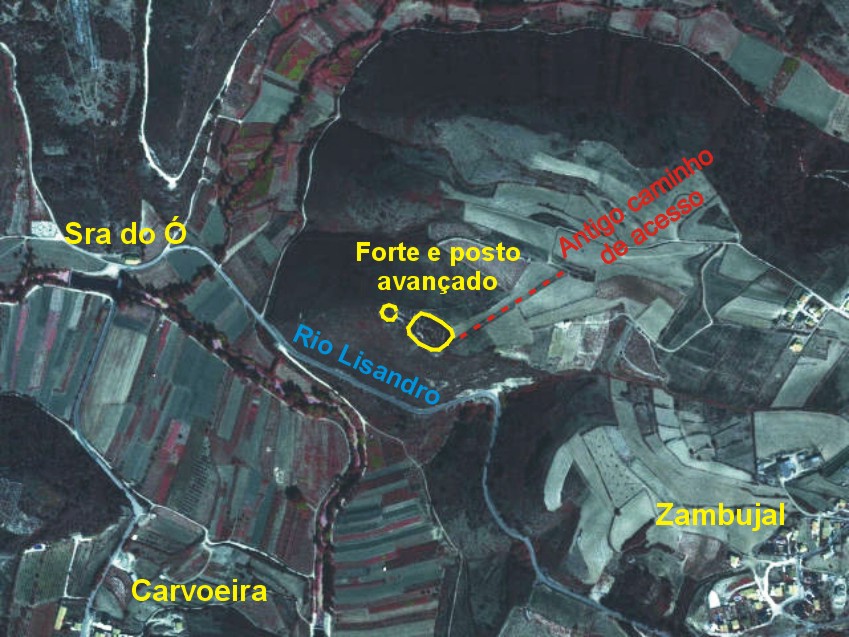
O Forte do Zambujal, localizado na Serra Gorda, numa posição sobranceira em relação ao Rio Lisandro e à sua afluente Ribeira da Vidigueira, trata-se de uma fortificação natural que aproveitava sabiamente as elevações do terreno, dominando desta forma toda a região envolvente, onde se situava a estrada que ligava Ericeira a Belas, passando pela Carvoeira.
Ainda hoje se descortina bem o fosso, apesar do imenso matagal, e uma pequena particularidade arquitectónica, com características únicas, que terão de descobrir quando o visitarem para procurar a cache.
Deixe o carro em N38 57.023 W9 23.064 e tenha uma boa caçada!
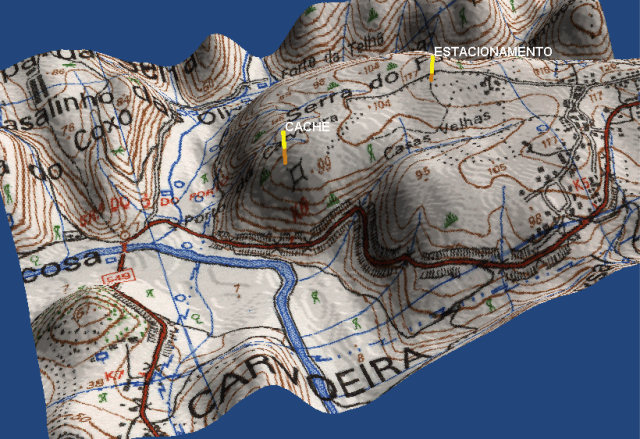
 At the time of the 3rd French invasion during the Peninsular war, Portuguese engineers together with the English army, built N of Lisbon a system of fortified buildings that ensured the defence of the capital and the expulsion of the French.
At the time of the 3rd French invasion during the Peninsular war, Portuguese engineers together with the English army, built N of Lisbon a system of fortified buildings that ensured the defence of the capital and the expulsion of the French.
The plans by Lord Wellington for the defence of Portugal essentially contemplated the defence of the capital city. Firstly, with the construction of forts destined to protect the embarkment places and secondly a series of forts destined to block the four main access ways through mounts and valleys into Lisbon from the north.
He would transform 800km2 of wild mounts in a natural and invincible fort around Lisbon. This was an extraordinary fort in front of a devastated region without provisions to supply the attacking force; the Tagus River dominated by the British squadron and 30.000 British troops constituted a concept of war previously unknown.
The "Lines of Torres", as they became known, passed the County of Mafra, having been constructed, from 1809, 48 of the 156 forts of this system of defense.
This county represented one of the main positions of the second line of defense, with forts having been built in the most important points, namely, Malveira, Gradil, Ribamar, Carvoeira, Mafra and Ericeira.
Today the vestiges of many of these forts and redoubts are almost always difficult to recognize and to access.
Within the Tapada de Mafra the forts of Sunível, Milhariça, Juncal and Silvério, that formed part of a set that followed the left margin of the Safarujo River until Ribamar, are still seen today.
Further south, as last line of resistance should the French armies overcome the second line of defense, the forts of São Julião (Cache "A Praia e o Rio "), Carvoeira and Zambujal, the latter of which the ruins are still visible although partially covered with vegetation.
The Fort of the Zambujal, located in the Serra Gorda, elevated in relation to the Lisandro River and its tributary, the Vidigueira Stream, can be considered a natural fortification that optimizes the terrains elevation and dominates the surrounding regions and where the old Ericeira-Carvoeira-Belas road was located.
Today, the moat is still discernible even though it is overrun with vegetation as well as a particular architectural feature that you will have to discover when searching for this cache.
Leave the car at N38 57.023 W9 23.064 and have a good hunt!
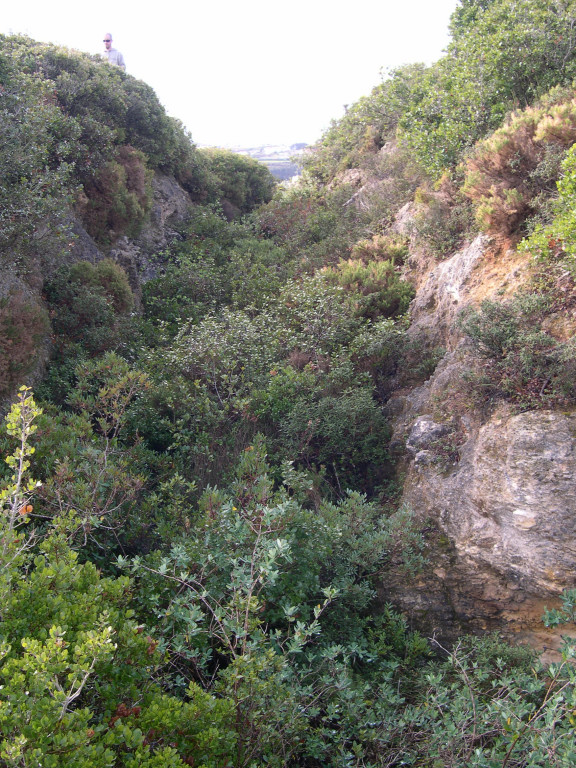 -
- 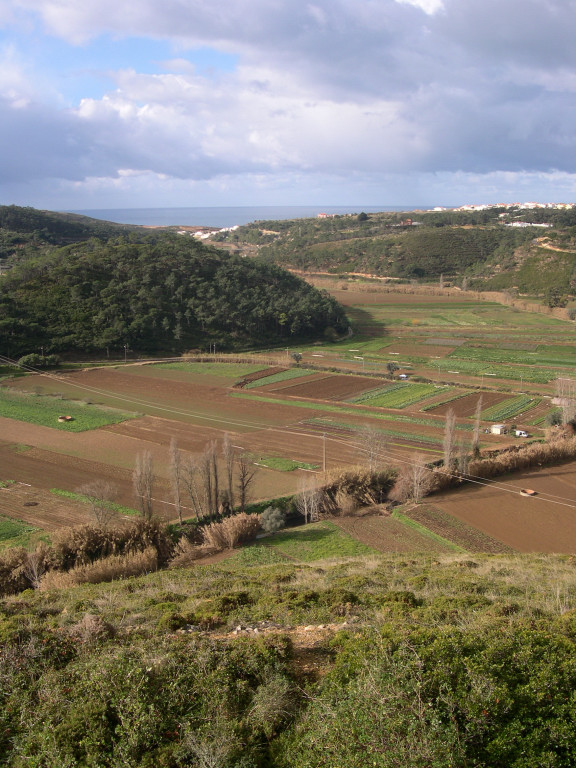
Referências/References:
Norris, A. H. & Bremner, R. W. (2001) – As Linhas de Torres Vedras. Museu Municipal de Leonel Trindade e British Historical Society de Portugal. 4ª edição.
http://www.mafra.net/historia/historia4.asp
LINHAS DE TORRES / LINES OF TORRES
 O projecto das caches dedicadas às Linhas de Torres compreende um total de 10 caches distribuidas por alguns dos locais mais emblemáticos desta estrutura defensiva, que compreendeu mais de 150 fortes e redutos, considerada pelos especialistas como um dos mais eficientes sistemas de fortificação de campo da História.
O projecto das caches dedicadas às Linhas de Torres compreende um total de 10 caches distribuidas por alguns dos locais mais emblemáticos desta estrutura defensiva, que compreendeu mais de 150 fortes e redutos, considerada pelos especialistas como um dos mais eficientes sistemas de fortificação de campo da História.
Cada uma das caches abarca uma diferente temática relacionadas com este episódio da defesa de Lisboa por parte das tropas portuguesas e inglesas, face à terceira invasão do exército francês, entre 1809 e 1810.
Ao encontrar cada uma das 10 caches, o visitante receberá do seu dono 1/10 de uma cronologia com os principais acontecimentos da Guerra Penínsular, em Portugal.
 The Torres Fortified Line consists of a series of 10 caches set amongst the most emblematic spots along this defensive structure, which saw the construction of 150 forts and was considered by military specialists as the most efficient system of field fortification.
The Torres Fortified Line consists of a series of 10 caches set amongst the most emblematic spots along this defensive structure, which saw the construction of 150 forts and was considered by military specialists as the most efficient system of field fortification.
Each cache deals with a different theme related with the episode of keeping Lisbon from the hands of the French between 1809 and 1810 by Portuguese and English troops.
On finding each of the caches, the visitor will receive from the cache owner a 1/10 of a excerpt with the main events in the Peninsular War in Portugal.



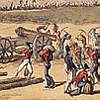

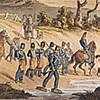

Quer saber mais sobre o Geocaching em Portugal?
Adere ao grupo de discussão e visita os sites Geocaching@PT,
GeoPorStats e os mapas com a localização das caches portuguesas
Would you like to know more about Geocaching in Portugal?
Join the discussion group and visit Geocaching@PT,
GeoPorStats and the maps with the location of the portuguese caches